The practicality of a sweater over the shoulders
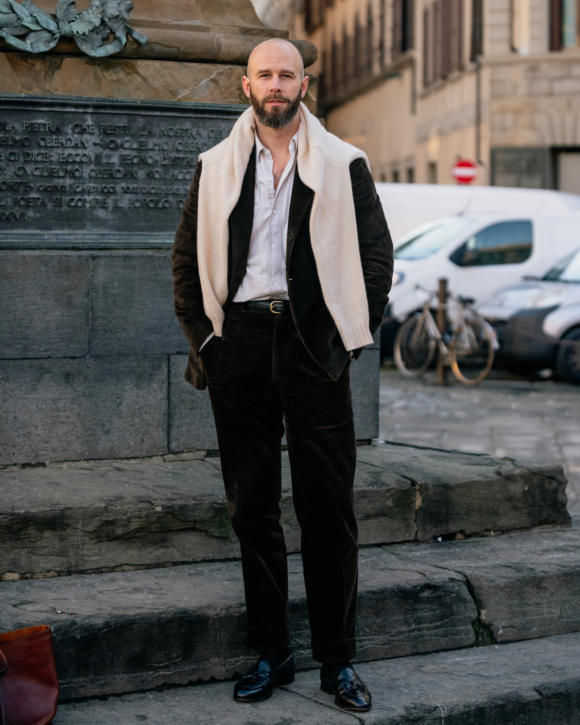
Wearing a sweater over the shoulders has a lot of negative connotations. But if you can get away with it - because of your style, of where you are, or just because of your personality - it’s incredibly practical.
This suit I wore at Pitti earlier in the year is a good example. The weather - like today in the UK - was cold in the morning and evening, but warm in the day in the sunshine. You’d feel silly carrying a coat over your arm all day, but freeze at night with just a jacket.
The knit provides several options. Draped across the shoulders, it provides a surprising amount of warmth; if thin enough, it can be worn under the jacket; when the temperature drops, it can be tied closely around the neck, with the jacket buttoned and perhaps collar popped; and if not needed at all, it’s easier to carry in a bag than a coat.
The difference in warmth between no knit, draped (above) and tied around the neck (below) is substantial. I had a cashmere watch cap in my bag too, as further back up.
The look has negative connotations mainly because it’s associated with a certain upper-class elitism - with the East Coast establishment in the US, a Sloaney type in the UK.
It’s a shame, because the look is both practical and stylish - the perfect menswear combination. It’s not only perfect for layering but provides another accessory, a colour and a texture, to play with in a tieless and hankless outfit.
Here, the heavy cream-cashmere of my Saman Amel knit compliments the deep colour of the brown cord suit. The cream is related - but different in tone and texture - to the vintage white workshirt. Add black shoes and a black belt, and the overall look is subtle but detailed.
You could do something similar with a cream scarf, but in some ways that would seem more unusual, not less, and wouldn’t have the same easy, relaxed feel.
So if you like the look, how can you go about avoiding the connotations?
One easy way is to stand out less by using a darker colour - such as a charcoal here. Another is to drape the knit, rather than tying it, as I do above, though that isn’t quite as practical as having it tied.
If you do tie it, you can do so roughly and not fuss with it - have it slightly to one side, one sleeve longer than the other and so on. Of course, this is sprezzatura, that much misunderstood term that refers to giving the impression of not trying, despite trying rather hard.
There has also been a recent streetwear trend of tying a sweatshirt diagonally across the body, but to me this looks more artificial still, being a trend. Though it is worth noting that a sweatshirt is probably easier to wear than a luxe piece of knitwear.
Those connotations aren’t universal either. During our recent talk with Carl and Oliver at Rubato, they highlighted that in Sweden there isn’t the same association. Japan, of course, plays with these Ivy looks much more freely too. And I’m sure PS readers can let us all know how it would be seen where they are.
Plus, it should be reaffirmed that just because something has a certain association, it doesn’t mean you shouldn’t do it. Either because you like playing with the effect clothes have in that manner, or because you simply and genuinely don’t care. As we discussed recently, no one dresses entirely for themselves or entirely for others.
Personally I’m happy to wear a sweater this way at Pitti or in Mayfair, but would feel more self-conscious about it at home. It doesn’t pass my so-called ‘bus-stop test’.
If I did do it locally, it would more likely be with a sweatshirt or a dark knit - and I would do so largely because it is so damned practical. I do enjoy it holiday, with a cotton knit usually. There’s a very particular pleasure in wearing a piece of knitwear over the shoulders with linen trousers in the evening.
The suit here is my brown corduroy, made unusually in two halves: jacket by Ciardi, and then later when I decided trousers would be good too, trousers by Whitcomb & Shaftesbury.
The shirt is a vintage work shirt from Stock Vintage in New York. It’s delightfully battered, and has a good collar (essential for wearing something vintage with tailoring). I like the way the soft grey colour that it has become looks more casual than white.
The belt is alligator from Rubato, the shoes my tassels in cordovan from Edward Green (also a practical travelling/weather choice).
The bag is my faithful old tote from Frank Clegg, which adds a nice touch of rich colour to the ensemble. And on an subsequent day when cold was less of a concern, I wore an old Polo pink-cotton cap instead of the cashmere PS Watch Cap (above). That was a nice touch of colour too.


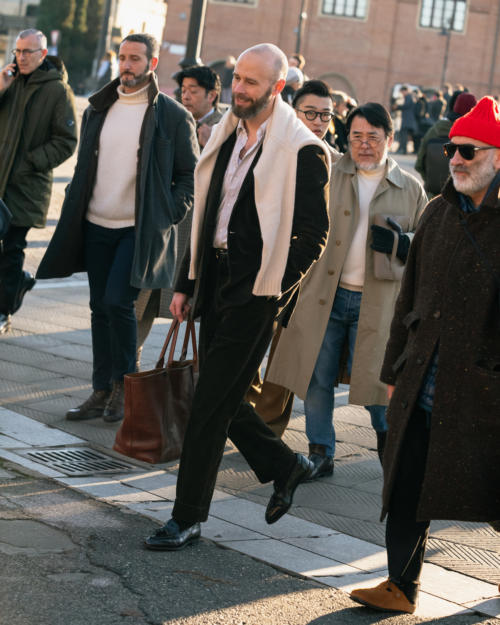
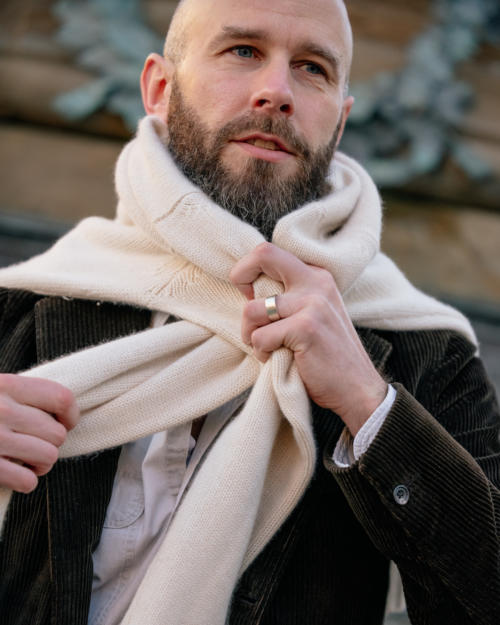

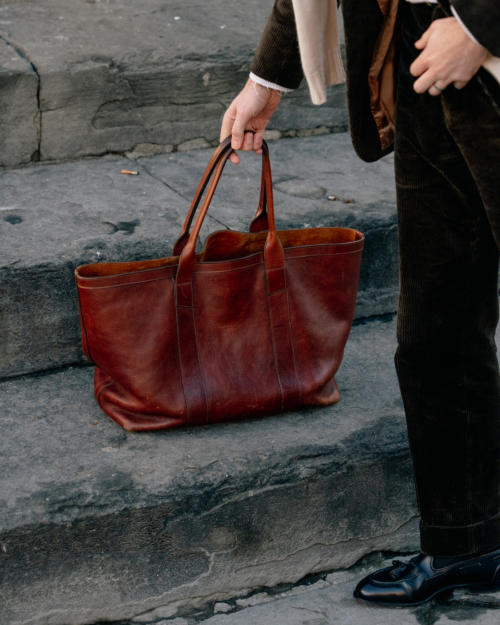

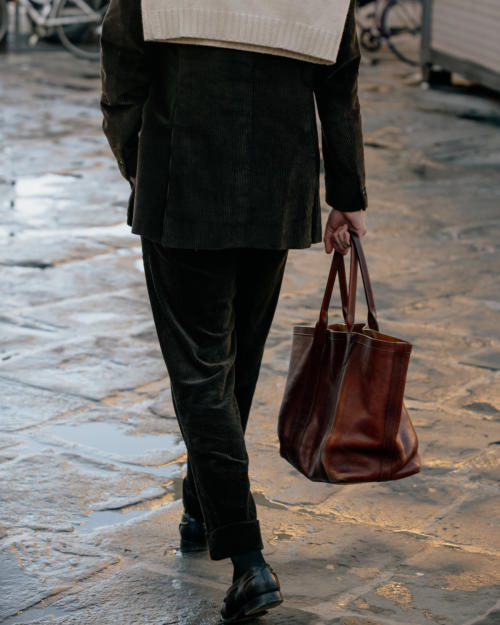


























I’ll add that in Japan, in addition to Ivy, draping a sweater over the shoulders has the negative connotation of a sleazy TV producer, particularly when done while wearing white trousers. (Oddly specific I know.) Doesn’t mean it can’t be pulled off, but definitely something to consider!
Huh, thanks Ryotaro. I assume that’s linked in that a TV presenter might often dress up more than someone else, show off a little more
I was just about to add the same. This sleazy TV producer look is even further amplified especially if the sweater is pink
Saying that though, I still do it as way of carrying a sweater after standing and teaching/lecturing for 1 ½ or 3. I’d rather run the gauntlet of said ‘producer’ type jibes than ruin the sleeves by tying them around my waist
Before reading this article, I never thought about negative associations….. but also never thought about intentionally using a pullover as a kind of scarf substitute. For me, the pullover around the shoulders – limited to light cotton ones – is a necessary evil when the day gets warmer in spring or early autumn and I have no other place to put it if I want to keep both hands free.
It can only help if it’s something that was actually necessary
The negative connotations that the pullover over shoulders bring in my case are difficult if not impossible to dissociate from it. In the North of Spain it reeks of a very traditionalist old money type. So much so that no one I know would dare to wear it.
I fully understand the practicality but we are products of our culture and society and in my case that is a no no.
I think a sweater over the shoulders, either with a long sleeve shirt and slacks, or polo shirt and shorts, is perfectly normal, and commonplace in warmer climes.
But a sweater like this worn over a jacket? Not for me thanks.
Ah good point Elliott, that does make a difference
Are we effecively talking about a cape substitute here? Historically, I believe this is the role a cape would have played, though perhaps being thicker and heavier. Perhaps we need lightweight capes to make a comeback as a transitional season accessory. Perhaps too novel for a PS collaboration. 🙂
I wouldn’t say so to be honest, as it’s so short on the back, and a cape was for protection from wet as well as warmth.
I’ve occasionally tried loosely tying the sleeves but, and maybe this is just a perspective thing, I always find it ends up looking far bulkier than the way anyone else does it. Do you find it bulky at all?
Yes, that definitely happens
I never wear knitwear that way because of the aforementioned negative associations, but I do wear hoodies that way (with casual clothing of course, preferably with a baseball cap and shorts). Hoodies have the additional advantage of usually being rather voluminous as compared to a merino crewneck knit for example, which alters the proportions of the whole outfit in a positive way, I think.
Had to laugh when I read about your “bus stop test”; I do the exact same thing, only I call it the “supermarket queue test”.
My family have the St Tropez test – it may look great there, but would it back in Britain?!
Nice
I’d say its a relatively trivial point from a UK perspective. I am aware of the connotations and i come from a very liberal city within the UK and more specifically grew up in a very left leaning social group [think anarchist and class war literature etc etc]. However it wouldn’t prevent me from wearing a jumper around my shoulders but it would be from a purely practical perspective. Indeed its not uncommon to see local teenagers doing this with track suits. I’m surprised it doesn’t pass your bus stop test Simon?
Interesting. It doesn’t for me, but then a lot of it is psychological to the wearer rather than always the viewer. I think it can be a little different when done in a more street fashion, with a sweatshirt
Wearing a jumper over the shoulders of a tailoring does not have upper class connotations; it just another affectation that you would associate with the Pitti peacocks and poseurs. A similar example is wearing an coat over the shoulder, i.e. not putting it on properly with the arms in the sleeves. Such affectations are attention-seeking rather than trying too hard. If it’s a bit cold, just wear a wide scarf or another layer of outerwear.
I think you could consider that there are other experiences other than your own Gary. It clearly does have those connotations to many people
I have to disagree about it being only an affectation – even though both looks can unfortunately appear that.
When I leave home in the morning (most days in spring and autumn where I live) it may be below 10°, coming back in the afternoon, it’ll be about 20°. Wearing a jumper for the morning commute, and throwing it over the shoulders later in the day makes perfect sense, especially that I might not have a lot of space in my bag. And when it’s quite chilly in the morning, and slightly less so during the day, wearing a coat the way you describe also makes you feel cooler, and keeps your hands free.
That’s different experiences, as Simon says, I actually don’t think I did this a lot when living in the UK where temperatures varied less, but in northern Italy there’s a practical justification.
Sorry Simon I have.given lots of other style flexes a go based on your suggestions over the years but this is one I will be avoiding – largely due to two words – “sports casual” – being an Englishman like myself of a certain age I expect you will get the reference!
The main point of the article is in the title. It’s practical in any place where the temperature may vary considerably during the day and evening. Not being British and therefore not having been trained to never acknowledge the cold, I’ve worn and carried sweaters – including over my shoulders – most times, also at local bus stops. It has never occurred to me that it had some connotation with elitist circles. If it has in continental Europe, it has in any event escaped me completely.
If it were true, could it be that the upper classes are eminently practical people and we would be better off following their example rather than being needlessly worried about it?
Or is it the influence of some working class machismo where one is rather cold than to show it?
I don’t think so either way Willem, I think it’s more just trends among classes that have worn sportswear in that way
If we were really to worry about negative connotations we would have little to wear if anything. What doesn’t have connotations?
I agree Darryl, everything does. But I’d still say it’s an area of nuance. Some things have much stronger connotations than others, some connotations are worse than others. And some people like or dislike connoting those things
If only the finest crewneck was available to purchase to do this!
Yes, the associations are very difficult to escape or ignore here. I often tie my jumper round my shoulders to tease my wife who HATES the look.
Funnily enough I found myself consciously invoking these associations: In Selfridges recently, I felt self-conscious being surrounded by ostentatious luxury and before asking to try a few garments, tied my jumper round my shoulders, almost getting in character, to channel a sort of old-money confidence and entitlement! Which is silly of course because I’m sure no-one would have said “be off with you, peasant” whatever I looked like but I think we all have a sense of places where we fit in and where we don’t.
The elitist association is very difficult to overcome. Certainly there’s a practical aspect as you mention, but I think I’d just keep the sweater in my bag and put it on when the temperature drops. This look can easily be considered an affectation and effete so I’d suggest avoiding it.
It’s such a shame. The warmth around the shoulders is so pleasurable and so practical as a halfway house
I think there is a world of difference between wearing a sweater draped over your (jacketless) shoulders, and wearing one over your jacketed shoulders.
The former is so commonplace, the latter so rare it would certainly raise eyebrows.
Thanks Allan. Where I am the former is certainly not commonplace, but I can see there’s certainly a difference
Hi Simon,
Agree there are some connotations, interestingly I think less so with how you have styled this look – suggesting pragmatism – rather than say a cotton sweater, polo and shorts at the more affected end of the spectrum. With the latter I wear a sweatshirt or cotton sweater – when I need to take one for practical purposes – tied around the waist.
All in all if you should feel confidently comfortable, but not necessarily whilst waiting for a bus! That did make me smile!
Interesting, thanks Stephen. It certainly seems to vary, given others think it has more connotations worn with tailoring
Yes that’s interesting and demonstrates the diversity of your readership. Perhaps try styling over an overcoat!
Thank you, Simon, for your excellent website.
In the NE United States, there are strong negative associations of the sweater over the shoulders.
One aspect of your look that changes this is pairing it with a suit. This would never be done traditionally when sweater over shoulders is paired with casual or sports clothing.
I find the carried sweater convenient in the NE US when the maritime weather can change suddenly or over the course of a day in certain seasons. The sweater can be tied around the waist and avoid the negative connotations. This was much more of my style as a younger man without a small tummy.
Thank you, and yes with a suit it’s certainly more unusual, though I feel the connotations either way personally
In Italy, a sweater over the shoulder does carry the same elitist connotation, but it is so practical in the summer that it becomes common enough to pass the bus-stop test almost everywhere. Still, most would drape it around the hips just to avoid that connotation.
This, supposing you are wearing just a shirt or a polo. An over the shoulder sweater while wearing a jacket would look really odd, the kind of stunt one would have expected Agnelli to perform.
I’ ve never seen anybody wearing a pullover like this over a jacket. Except the lady from New York you Interviewed some time ago.
The connotation here is “school teaxher”.
Really? How interesting, thank you
Personally,I think it’s fine with shorts and it’s something I do regularly n the Summer with basically any shirt,polo or tee.
I can see the practicality of it, I just think it spoils the elegant line of a tailored jacket.
A fellow Swede here. My association is definitely middle aged man wearing a brightly coloured polo shirt, shorts and boat shoes on a summer night – sort of aspirational/new money flaunting. The tasteful color combination and wearing it with a suit, however, offsets these connotations a bit. That suit is just too beautiful.
Im young and here in spain a lot of young people do the diagonal sweatshirt cross to avoid that conservative connotation since i can remember. Funnily enough, the place where i have seen this the most is at night clubs where most people run hot!
THIS IS MY SUPER BOWL. HERE FOR IT.
I think that leaving the house with a sweater in the morning and then, as the temperature increase, wear it over the shoulders (or around the waist, something that I can only imagine is not PS approved but that I do all the time :)) is normal and natural. The example that is shown in this post is a bit different. A jumper worn over a suit (and a corduroy one) just looks a bit weird and forced, specially considering that there is also a relatively empty tote available to carry it. This final detail is important because it removes the “not trying” aspect from the equation and makes it evident that there is a conscious intent to go for a look. Nothing wrong with that by the way, but not a look that I find aesthetically and/or intellectually satisfying.
Thanks Diego. I think the latter point though is affected by the fact that it is a cold day, everyone is aware of that, and the sweater is there for warmth – it’s not just to make it easier to carry
I would just wear a silk scarf. In the Midwest USA it would feel awkward to tie a good sweater around one’s neck. Perhaps, while wearing a shirt and trousers it would be less awkward.
I did this for years without being aware of any connotations whatsoever, on the basis that I had found the day warmer than I expected, and it was the easiest way to carry my jumper without ruining the shape. I admit I was rather exasperated when I learnt that doing so was regarded as an affectation in some quarters! Wearing a jumper in this way over a jacket just seems odd, though. Why not wear the jumper, and carry the jacket, if you must?
Because that wouldn’t be as warm – the point is having the jumper just around the shoulders is a really nice halfway between wearing both or wearing just one. Plus of course you’d then have to carry one, as you say
It’s interesting to see the many perspectives Simon, and I’m left with the view that the draped sweater has negative connotations in more countries than you had expected.
The alternative?
You touched on the obvious one of a scarf and hint that it may be even harder to pull off, but I have found that the opposite is true. It’s really quite common, especially in western European mainland countries, to wear a scarf in exactly the same countries where the sweater is seen as dodgy. I’ve been a convert for some years and I’ve had no weird looks extending its range to the US, Ireland, UK. Of course it can’t be swung into action to deliver the insulation of a sweater, but it’s surprising how comfortable a warm neck can be – such that you seldom actually need “torso insulation”. The scarf is more portable and has more styling options (colour, pattern, knot, weight/length/width).
Here’s to the scarf 😉
Interesting the different negative connotations that these thoughts have thrown up from around the world: to me it just reminds me of the “Kays Catalogue” look! I probably have ocassionally put a jumper over my shoulders out of necessisity but it isn’t a natural look for me. In the sort of climate you are talking about I would probably just wear shirt, thin merino crew, jacket and then carry a buff (which is light and practical and surprisingly warm while, in navy or dark grey, is suitably stylish) and wool beanie to regulate temperature.
I confess that I sometimes am a tad too rough. Late nights, a penchant for partying too hard and a near-constant state of FOMO.
My sweaters suffer from it. When they are used as pillows, take damage when I fall over during a stunt or the like. Only the Ruggers don’t show their wear.
I enjoy the patina, and patching them up, but some are frankly beyond saving. However, I’ve given them a second life by tying them around my shoulders.
Their new purpose as “scarves” adds personality to my more somber outfits, and frankly, it just feels more sustainable.
Definitely a very practical trick.
I understand what Mr Crompton says about “connotations” (and also with the fact they are essentially an Anglosphere thing…) but the best way to address any sort of unexamined social assumption is to ignore it, in my opinion.
I personally would prefer a scarf to a sweater over the shoulder, at least with tailored clothing. The sweater breaks up the lines of the tailored jacket, and is a bit cumbersome. Nothing to do with negative connotations of the sweater on shoulders, though, and I think it’s fine with a polo shirt or more casual clothing.
Hi! Here’s Ismael from Spain. In the North of Spain (Basque Country) that way of “wear” a pullover was almost a distinctive characteristic in the seventies/eigthies!!! Wear it “properly” over your body meant that you could’n stand the climate (you’re not a real Basque= your’re not one of us)
That time was usual enter a store to purchase a sweater regardless it’s size, as it was intended to wear only over your shoulders around the neck…
Ha! Love it, thanks Ismael
As to associations and clothing choices, I find myself more concerned about such considerations when I am feeling insecure—for whatever reason. When I am feeling confident, I am more likely to wear whatever I want. Having said that, for me, the whole sweater around the shoulders concept is rooted in practicality. If the weather turns really warm, I tie the sweater around my waist. If it is less warm, I leave it on my shoulders. As to then tying the sweater, heavier sweaters are often too bulky to tie. But I just don’t get the sweater over a jacket idea unless the sweater is originally worn under the jacket and it then becomes too warm. Alas, I am too chubby to wear sweaters under my jackets!
Hi Simon , I’ve been wearing a sweatshirt or jumper this way for years and it’s a great way to help regulate the body temperature and stops heat escaping from the back and neck Activity and location also play a part in this. It’s very common in Italy and is not class influenced. Wearing a scarf or hat keeps in heat. Rolling up shirt (or jumper) sleeves or wearing shorter length trousers allows heat to escape. Simple and totally practical! Not everything has to be a ‘look’ .
Regards Dan
Thanks Dan
Always used one, very practical, and luckily it works for me.
Hiya , could you tell me where I can buy your herringbone Ragland overcoat please?
Have you looked on the Shop site? See the menu
Simon,
I have a beige, cashmere, cable knit, Paul Stuart (a mouthful) sweater that is nicely frayed at the collar. It serves multiple duties: over the shoulders for cool Charleston evenings dining al fresco, always with me on frigid airplane cabins, and my Westie, Nacho’s, blankie to snuggle into on road trips. Cheers,
Hello Simon,
I’m sorry for posting a comment that is unrelated to this article subject, but I truly hope that you write a review of the newly released Fireman’s Jacket from Rubato.
Best regards,
Daniel
Thanks Daniel, noted
Have you ever tried a shawl? My Indian travels have shown how versatile and useful a shawl is. Perhaps you guys are wary – your loss. And great for travel and day into evening.
I did used to wear a big shawl this way, but I confess it was too unusual for me
I find it sad that grown up men make such a fuzz about “connotations“. Aren’t we here to make our own stylistic footprint ? Thanks Simon for your good work and stating that we should not bother…
It isn’t ideal, but most of what we think about clothes is unfortunately connotations and associations I think
I cannot believe no one has mentioned Patrick Johnson! He makes this style seem so easy and natural that I barely even notice it in photographs. I also think that the color combination that Simon is using here illustrates that the “look” can be accomplished with subtly that does not attract attention.
I live on the East Coast in the U.S. and understand the connotations with elitism. However, I think this much more obvious when the sweater is in a bright or loud color that draws attention to itself. Think Polo ads with pink cable knits paired with chinos or shorts. For me it is not an issue but I somewhat understand if one is not comfortable wit the style.
As far a practically, I completely agree with Simon when it come to warmth. I have worn thin knits this way and have found them very practical if nothing else.
Even though this style may not have the same history with the upper class in Sweden, I think a fair amount of Swedes are aware of the connection. People born in the early 80s and later grew up with access to US shows, and we are very found of importing US culture and fads. I strongly associate that look with the mass-market prep that emerged in the 80s and 90s, and I avoided it for years because I associated it with smugly wholesome (upper) middle class kids. I wasn’t really aware of the origins of preppy and ivy style until quite recently, though.
Today, I quite like the look. First because it’s so practical – the sweater can be worn, thrown over the shoulders, or carried with far less effort than one carries a jacket, and second because it’s a way to make the silhouette of a summer outfit a bit more interesting.
I guess I’m also at a point in time where I just don’t care as much about the association. We live in an age of clickbait, crypto, athleisure, and people measuring their careers on how many hours of overtime they work. The idea of old money suddenly starts sounding appealing.
I began trying this on cool early spring mornings this year, and found the warmth, and style, perfect. I tucked the sweater sleeves inside my buttoned suit jacket for a more polished look than tied or dangling, which added to the warmth.
To my eye there are some angles from which it looks like you forgot to put your jumper on before your jacket, and others where it looks like you are wearing a gilet over your jacket.
There are no angles where it looks like a “practical” choice.
I think this is because the jumper is draped over a jacket. I can see, in certain climates, it would be practical to have a piece of knitwear draped across your shoulders over a shirt. When you throw a jacket in the mix it looks like an affectation, or just a bad choice of clothing (a scarf or a warmer jacket/better outerwear seems much more practical).
Thanks H, though it certainly is practical, and less warm than wearing the sweater underneath the jacket – a nice mid-way
Reactions to this may also be generational. For me – British and now in my 70s – a sweater worn over the shoulders has the connotation not so much of old money but of new money/classes trying to gain status by imitating old money/classes.
In Britain, it may come from the 60s/70s/80s when foreign travel was opening up to the new moneyed professional and managerial middle class and they were copying what they saw or imagined the old money would wear on holiday in an upmarket resort.
I think that by the 90s and after afterwards, as many more people had holidays abroad, that look was seen as naff (what people wore who didn’t go abroad much) and resort wear became much more casual.
Plane travel was much the same; sometime in the 80s people stopped dressing up to fly. Before that a plane trip showed your status in terms of job or money so you dressed well. After that many more people were flying, but only not more than once or twice a year, so dressing casually or even shabbily for a flight showed your status as well-travelled and comfort/functionality was the priority.
Hi to all!!!
I’m very susrprised by the negative connotations of a thing that is so natural (and almost invisible) in the country/region where I live.
Here in South America (Argentine especifically, but also Uruguay, South Brasil, Paraguay, Chile, etc) a sweater over the shoulders is a “default” option when the weather is somewhat unpredictable.
The thing is a funny typical “Grandma-advice”: “…llevate un pulovercito sobre los hombros por si refresca…” (“…take a little sweater over the shoulders, just in case it cools down…”), but nothing nearest a negative connotation, even in all social estate. I guess the deep influence of the Italian inmigration here, would have things to say.
Said that, I think is a very valuable style trick, so add some (in)famous “sprezzatura” to any casual/semi-formal look, a new element of colour/texture, almost like an accesory. In the other hand, the sweater is never (but never) used over a jacket, suit, coat, etc.
Regards.
Being a fellow swede, I can confirm the only time someone has commented on my habit of wearing a knit as such, are non swedes.
A gallerist friend, who works at the Art Basel fairs said that sweater drape as described is a reliable sign (in his world) that the buyer is both loaded and probably a mark. I have no means of confirming this information.
I love this look and have been doing it daily during spring/autumn for the last few years
I’ve basically been substituting a sweater (over the shoulders) for a scarf.
I wear a navy suit and have a lilac sweater which gives a nice pop of colour.
I often dress it down with trainers which I find helps
I also wear this look with other jackets (Harrington, denim etc) not just tailoring!
It helps that I’ve got quite a few tattoos so it counteracts any “upper class” connotations!
Hi Simon, your sweater reminds a bit if the Alpaca Rubato one. Have you ever tried this one?
I haven’t, though I’ve seen them in person. It’s a really nice fibre – the knit feels more substantial than the others, but not too hairy. The neckline is a bit more pronounced because of that thickness, which is the only thing that I’d think about before buying
Hi Simon. An interesting read but I am struggling with this article to be honest. I am trying to think why and I suspect – putting aside the “association” point – it’s just that I don’t think this is actually very practical, as I find that a jumper over the shoulders falls off with movement. If you tie the sleeves together to prevent that, they stretch and lose shape. This then just feels a bit like sunglasses on top of your head: not really practical and it just looks a bit try-to-hard for me.
Understood Rob. I personally find it doesn’t really fall off, but then it depends what I’m doing that day – I’m just walking around town and chatting, not playing with the kids. And, if I tie the sleeves I don’t find they stretch at all – it’s pretty easy not to pull at them hard.